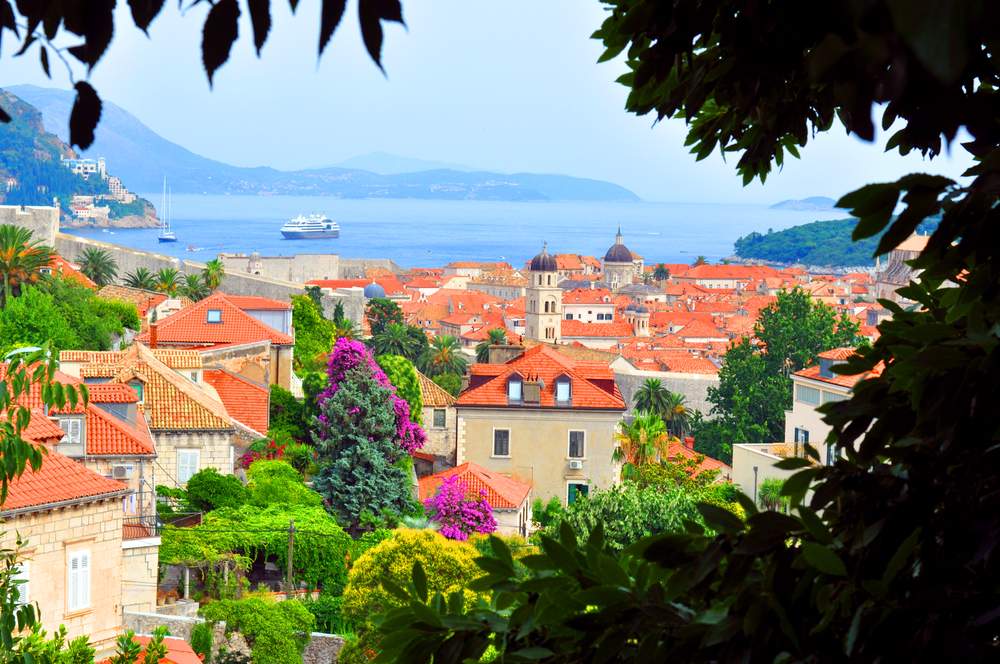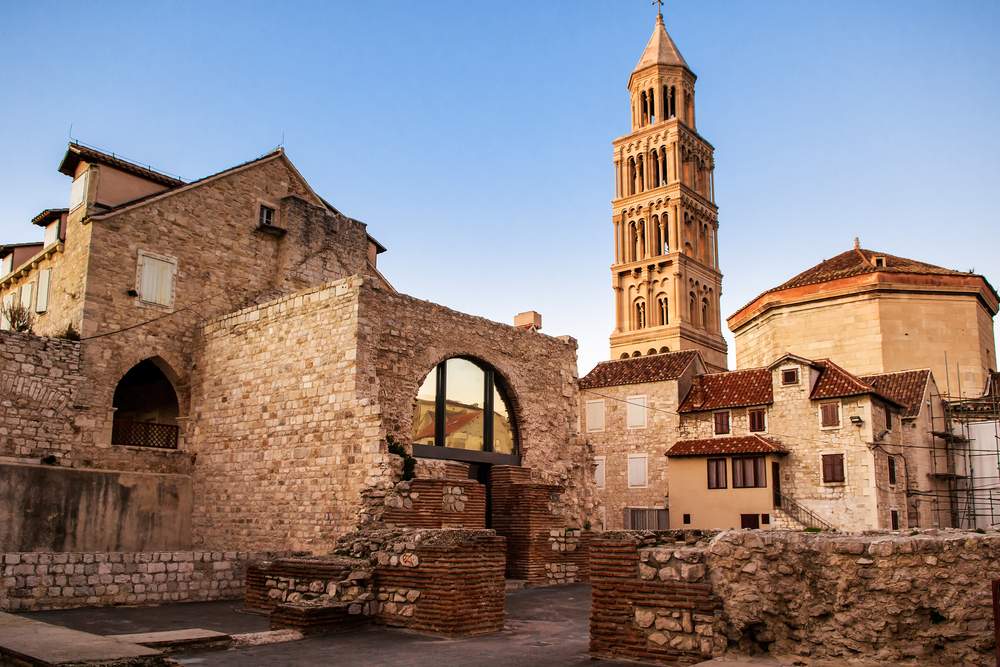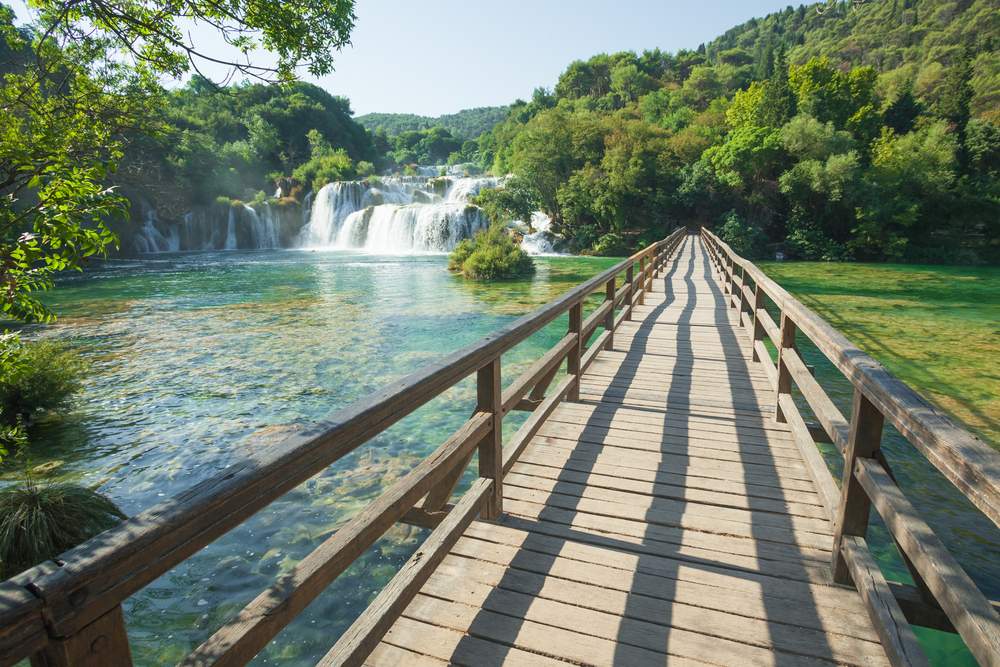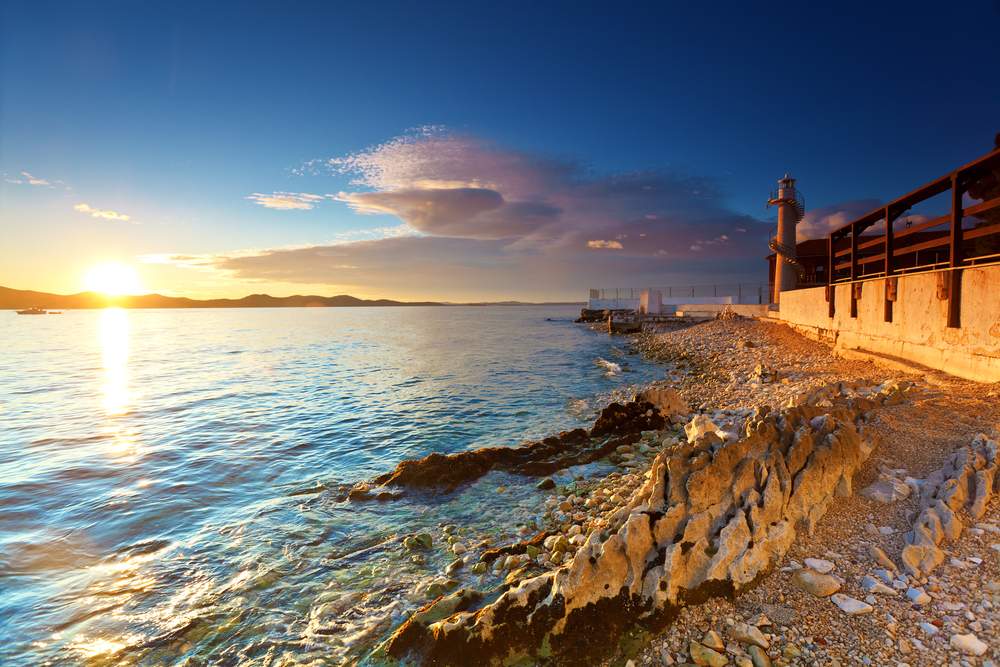To get to know Croatia, start on the coast. Just barely the size of West Virginia,
Croatia has more than 3,600 miles of coastline and 1,200 islands. The jagged landscape of limestone formations rises up from the Adriatic Sea, transfiguring into mountains as it reaches for the clouds – Croatia’s coastline looks life-threatening. Fortunately, we travelers get to chill out on the pebble beaches peppered between the steep crags,
go island-hopping by sailboat, hike in the national parks,
tour ancient Roman ruins and medieval towns, and, my personal favorite, eat good food and drink good wine.
“When visiting
Croatia’s coast, it’s important to know that the Venetian Empire controlled most of it between 1400 and 1800, roughly.”
When visiting
Croatia’s coast, it’s important to know that the Venetian Empire controlled most of it between 1400 and 1800, roughly. The city of
Rovinj was part of Italy until the end of WWII, and it remains bi-lingual today. There are many similarities between Italian and Croatian cultures, from Mediterranean cuisine and pasta to Venetian architecture and a laid-back attitude.
However, Croatia has forged its own identity, one that mixes Western and Mediterranean histories. Its thriving tourism industry even helped the young country gain EU membership.
Dubrovnik

For first-time visitors to Croatia,
Dubrovnik is the place to begin a tour of the coast. Even Dubrovnik’s famous walls, which surrounded the entire medieval city with saw-toothed crenulations, can’t keep the hordes of tourists out. On the plus side, this means there are lots of traveler resources available, which softens the transition from speaking English to speaking Croatian. More importantly, Dubrovnik, like Venice and
Lisbon, is worth fighting the throng.
The Old Town, which sits on a peninsula almost in the middle of the sea, has remained mostly untouched since the 16th century. You can circumnavigate the city by walking high up on the walls, some of the last of their kind (most of Europe’s city walls were torn down by Napoleon to protect against the plagues) and get plunging views of the Adriatic Sea.
“Even Dubrovnik’s famous walls, which surrounded the entire medieval city with saw-toothed crenulations, can’t keep the hordes of tourists out.”
Outside of the Old Town, Dubrovnik is modern but relaxed, with a nice bay and a few beaches. When the summer sun is shining down, you’ll want to head to the nearby islands of Lokrum and Lopud, which are easy to access by ferry; their pebble beaches are quieter than Dubrovnik’s.
The spicy scents of Dubrovnik’s restaurants waft through the cobblestone streets. Local chefs like to kick it up a notch, adding paprika and other Middle Eastern spices. Try Nautika Restaurant for a fine-dining experience featuring traditional Mediterranean seafood dishes. Dubrovnik is a good place for securing budget accommodations thanks to the many locals who rent private rooms. Accessible by plane and bus, Dubrovnik is the southernmost city in Croatia: a complete tour of the coast awaits.
Split

Split is the largest city on the Croatian coast, located in the middle of the Dalmatian Coast. Home to Croatia’s most impressive ancient ruins, Split’s Old Town actually occupies the same area as the retirement palace of Emperor Diocletian, one of the greatest Roman emperors ever to have lived. Whether you sip an espresso near the Cathedral of St. Domnius or go shopping at the daily subterranean market, you’ll be surrounded by the Corinthian pillars and tuff stone walls. Check out the lively fish market in the town center, where you can sample deliciously tender anchovies or observe fishermen squeezing the ink from cuttlefish.
Make sure to take a tour of the subterranean parts of Diocletian’s palace, which costs roughly $14USD and provides deeper insight into the Emperor’s zany and tragic habits. Diocletian, one of the only Roman emperors to live to old age and paranoid that a Brutus might be lurking nearby, ordered his palace be built without any windows. This is especially tragic when you consider its location just meters from the sea. Diocletian also made it illegal for others to initiate speech or even eye contact with him. The punishment for breaking these rules was sudden death.
“The town that Diocletian ruled wasn’t actually Split but Solin (called Salona back in the day), located three miles inland from Split. Solin has impressive ruins of an amphitheater and many sarcophagi; it can be easily reached by city bus #1.”
Split has an excellent culinary scene influenced by Mediterranean and Bosnian cooking styles. For traditional atmosphere and authentic food, have a meal at Konoba Varos. Try the rich, aromatic pašticada: beef stewed in a complex sauce of fruit, sparkling wine, and herbs served over pasta, usually gnocchi. Afterward, sleep off your meal without breaking the bank: a bed in a youth hostel can cost less than $10USD a night.
The town that Diocletian ruled wasn’t actually Split but Solin (called Salona back in the day), located three miles inland from Split. Solin has impressive ruins of an amphitheater and many sarcophagi; it can be easily reached by city bus #1.
Sibenik

Drive an hour north and you’ll find the coastal town of Sibenik, located on a huge protected harbor. Boats sail lazily in and out of the bay between the massive limestone cliffs that protect it. Sibenik serves as a great base for exploring the Krka National Park. Rent a sailboat and you can sail behind some of the park’s crashing waterfalls; the park is also accessible by bus and ferry from Sibenik, but renting a car gives you the freedom to tour the park at your own speed.
“The several waterfalls that comprise Skradinski Buk fall into a serene pool, and there’s no better way cool off on a hot Croatian day than jumping in for a swim.”
The park isn’t quite as impressive as Plitvice National Park, located in inland Croatia, but the roaring, multi-tiered Skradinski Buk waterfalls does come close. The several waterfalls that comprise Skradinski Buk fall into a serene pool, and there’s no better way cool off on a hot Croatian day than jumping in for a swim. Dining options in the park are limited and expensive, so pack a picnic lunch of local prsut prosciutto and the famous Paski Sir cheese from the island of Pag.
Sibenik is less crowded than most of Croatia’s coastal cities, and it’s a great place to sit back and relax, soak up the sun and explore the cobblestone streets. The Krka River meets the Adriatic Sea in Sibenik’s bay, and this mix of fresh and salt water is the perfect environment for shellfish. Try the area’s famous buzara sauce, which features white wine and loads of paprika, over mussels. The restaurant Konoba Dalmatino serves an intensely flavorful version.
Zadar

Tourists tend to put Zadar toward the bottom of the list of Croatia’s coastal cities, which means that it’s a great place to immerse oneself in Croatian culture. Cafés fill the small piazzas, fishermen toss their lines on the waterfront, and the warm scents of traditional strukli and burek pastries swirl out of bakeries. The daily market, one of Croatia’s best, overflows with fresh produce, local honey and cheeses, and herbal essences.
“Cafés fill the small piazzas, fishermen toss their lines on the waterfront, and the warm scents of traditional strukli and burek pastries swirl out of bakeries.”
The city is on a peninsula—-turquoise waters surround it on three sides—-and the famous Sea Organ, which plays its haunting tune all night and day, is a unique combination of engineering and artistry: organ pipes were built into the seaside promenade and are played by the waves of the Adriatic Sea. Sunset is a great time to visit the Sea Organ; people gather to celebrate the coming of night, illuminated by a series of lights built into the promenade, swirling their designs in time with the organ.
Zadar was once a Roman city, and the main square, called the Forum, is an outdoor museum, featuring both Roman ruins and the large 11th-century Church of San Donat. Don’t miss the nearby Gold and Silver of Zadar museum located in the Benedictine Convent, next to the Church of St. Mary: it features a huge number of relics and artworks made of precious metals. Zadar has a handful of cheap apartments that are rented out by locals and typically cost $30-50USD a night for two people.
Rovinj

The Istrian peninsula comprises the northern portion of Croatia’s coast. It was part of Italy until the end of WWII, and the town of Rovinj, where the foundations of seaside homes plunge straight into the waves, is immediately reminiscent of Venice, Italy. Venice is a three-hour drive away and Trieste is less than two hours, and much of the Istrian peninsula, including Rovinj, is bilingual. Rovinj’s Old Town, located on what was an island until a land bridge was built, is something of an art colony. Painters and illustrators are a regular sight along the web of romantic cobblestone streets.
“…the town of Rovinj, where the foundations of seaside homes plunge straight into the waves, is immediately reminiscent of Venice, Italy.”
Though Rovinj has two or three important sights—the bell tower of Saint Euphemia Cathedral is one of the best—the town is all about soaking up the sun and then partying through the night. Cafés, bars, and nightclubs spill out onto the rocky shore and beaches. The Zlatni Rt municipal park, located on the mainland portion of Rovinj, has sand beaches and coastal hiking trails for relaxed tromping. Rovinj serves as an excellent base for exploring Istria’s famous hilltop towns, such as Groznjan and Motovun, which are known for their culinary delicacies.
A culinary hotspot, the Istrian peninsula is home to high-quality olive oil, wine, and white truffles. During the summer months, ferries run between Venice and Rovinj; the ride takes around three hours. Rovinj is short on cheap hotels, and most budget hotels cost around $60 a night. For a five-star experience, stay in the new Lone Hotel, located in the forest of Zlatni Rt park. The rooms are spacious and feature a perfect balance of cool décor and functionality; balconies have views of the manicured grounds, including a salt-water swimming pool.
Find cheap flights to Croatia, look for Croatia hostels, or read more about travel in the Mediterranean:
The author was a guest of the Croatian Tourist Board.
Photos Credits: Shutterstock.com, magicinfoto /Shutterstock.com, Alana75 /Shutterstock.com, nomadFra /Shutterstock.com, paul prescott /Shutterstock.com, Phant /Shutterstock.com, Sasha Samardzija.




